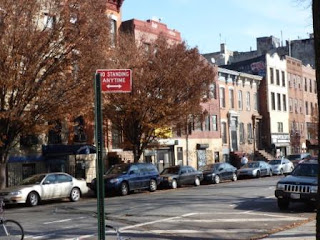The other day was unusually warm for this time of year: The temperature reached 69F (20C) and there were wispy high clouds. I don't think we'll see another day like that until April or, perhaps, March. I was fortunate enough to get home early and take Arielle for a spin.
I rode out to Rockaway Beach. The ride seemed strangely arduous for one that is almost entirely flat. Have I gained more weight?, I wondered. Is something out of adjustment? (A quick glance told me the answer was "no.") Or should I have eaten something besides oatmeal cookies for lunch?
Well, I got my answer at the Rockaway boardwalk. Another cyclist and I were playing tag along the long straightaways and bridges from Howard Beach into Broad Channel and Rockaway Beach. I learned his name: Devon. "Good workout riding into the wind, isn't it?"
He was indeed right: The wind whipped flags like whitecaps. I could feel it as I was riding, but somehow I didn't think of it as the reason I was (or seemed to be) riding slowly. Perhaps I didn't think about it because, as bracing as it was, it was not a cold wind, as it came directly off the ocean to the south of us. While the water temperature has dropped since August, it's still about twenty degrees warmer than it will be in February.
As we rode back, I realized that we'd actually been keeping a fairly good pace. Even in that wind, the ride down to Rockaway Beach didn't take much longer than it normally would; now, on our way back, we were practically flying.
It may be a while in coming, but I'm sure there will be another day, and another ride, like what I experienced the other day. And perhaps I will run into Devon again.
I rode out to Rockaway Beach. The ride seemed strangely arduous for one that is almost entirely flat. Have I gained more weight?, I wondered. Is something out of adjustment? (A quick glance told me the answer was "no.") Or should I have eaten something besides oatmeal cookies for lunch?
Well, I got my answer at the Rockaway boardwalk. Another cyclist and I were playing tag along the long straightaways and bridges from Howard Beach into Broad Channel and Rockaway Beach. I learned his name: Devon. "Good workout riding into the wind, isn't it?"
He was indeed right: The wind whipped flags like whitecaps. I could feel it as I was riding, but somehow I didn't think of it as the reason I was (or seemed to be) riding slowly. Perhaps I didn't think about it because, as bracing as it was, it was not a cold wind, as it came directly off the ocean to the south of us. While the water temperature has dropped since August, it's still about twenty degrees warmer than it will be in February.
As we rode back, I realized that we'd actually been keeping a fairly good pace. Even in that wind, the ride down to Rockaway Beach didn't take much longer than it normally would; now, on our way back, we were practically flying.
It may be a while in coming, but I'm sure there will be another day, and another ride, like what I experienced the other day. And perhaps I will run into Devon again.

























